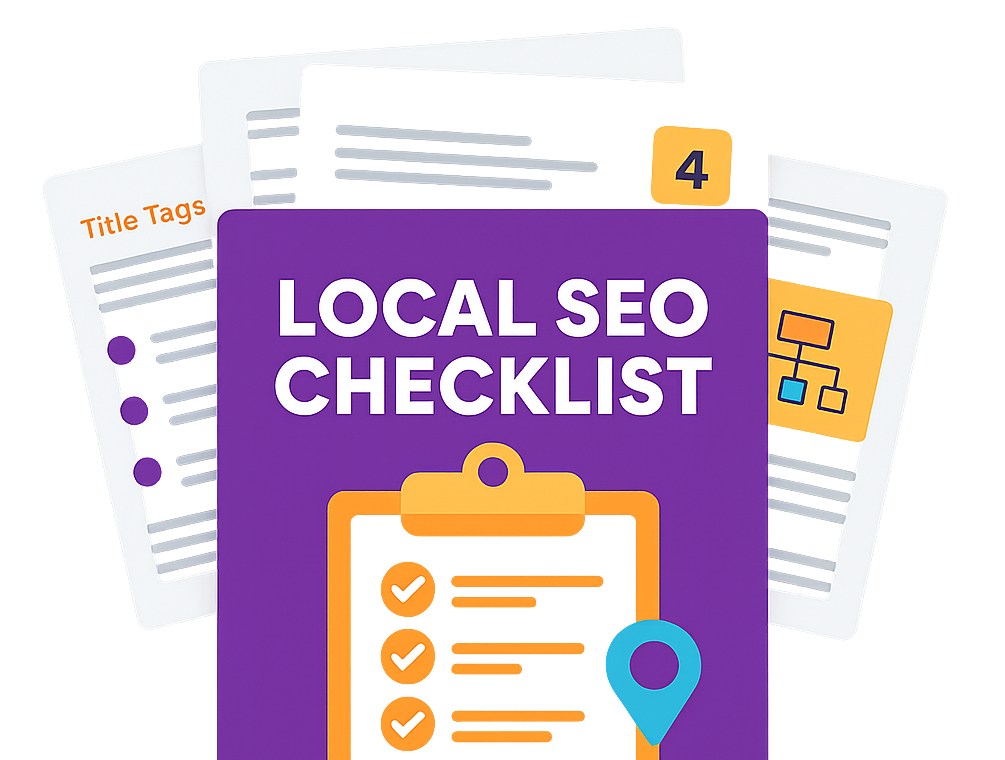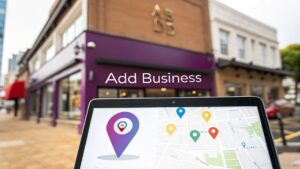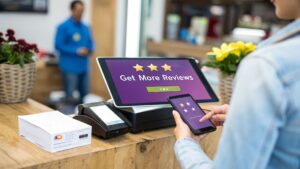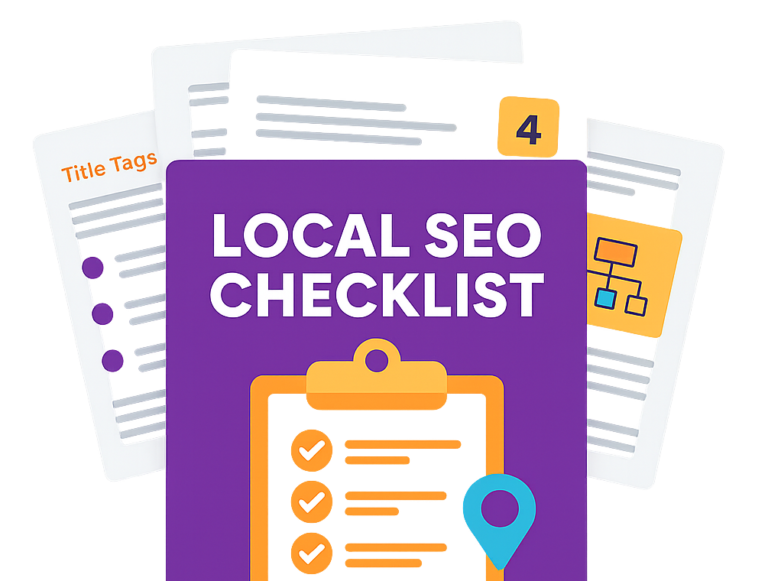Figuring out how to get more visitors to your website can feel like you’re trying to solve a massive, complicated puzzle. But honestly, the formula for sustainable growth is surprisingly straightforward. It boils down to a powerful combination of technical excellence, compelling content, and authoritative outreach.
This isn't about just churning out articles and hoping for the best. It’s about building a solid foundation that consistently attracts the right people to your site.
Laying the Groundwork for Traffic Growth
Before we get into the nitty-gritty tactics, it’s crucial to understand what actually moves the needle. So many website owners fall into the trap of chasing quick wins or putting all their energy into one thing, like social media, without any real strategy. That approach is a recipe for wasted effort and disappointing results.
A truly successful strategy is built on three pillars that are completely intertwined. They work together to create unstoppable momentum.
The first pillar is a technically sound website. Think of it as the foundation of your house. If that foundation is cracked—with slow page speeds, a clunky mobile experience, or confusing navigation—everything you build on top of it will be wobbly and unstable. Search engines like Google are obsessed with user experience, and a technically flawed site sends all the wrong signals.
Next up is compelling content. And I don't just mean writing blog posts. I’m talking about creating genuinely valuable resources that get right to the heart of your audience's questions and solve their real-world problems. Your content is the very thing that brings people to your site. Without it, even a technically perfect website is just an empty, undiscovered shell.
The final, and equally important, pillar is authoritative outreach. This is all about building your website’s reputation across the web. When other reputable sites link back to you, it's a massive vote of confidence in the eyes of search engines. This process of digital PR and link-building tells them your content is trustworthy and deserves to be shown to a much wider audience.
How These Pillars Work Together
These three elements don't work in isolation; they’re deeply connected and feed into each other.
- A solid technical SEO setup makes it easy for search engines to discover and make sense of your content.
- Great content gives other websites a compelling reason to link to you, which in turn builds your authority.
- The authority you gain from outreach and backlinks helps your content rank higher, driving even more traffic.
If you neglect one pillar, you'll inevitably weaken the others. You could write the most brilliant article in the world, but if your site takes ten seconds to load, no one is going to stick around long enough to read it. By the same token, a lightning-fast, beautiful site with nothing valuable to say will never attract or keep visitors.
Key Takeaway: Getting more website traffic isn’t about some secret trick. It's about systematically strengthening your technical foundation, creating genuinely helpful content, and building your site's authority over time. This holistic approach is what creates sustainable, long-term growth.
The potential audience you can reach is massive and only getting bigger. In the United Kingdom, for instance, the internet penetration rate hit 97.8% of the population as of January 2025. That’s a staggering 67.8 million internet users. This highlights the vast opportunity available to businesses that get their strategy right. You can explore more data on UK internet usage in the full report.
Mastering Technical SEO for Search Visibility
If your website were a car, technical SEO would be its engine. You could have the most beautifully designed bodywork and a plush interior, but if the engine isn't finely tuned, you’re not going anywhere fast. This is where you start improving website traffic from the ground up, making sure your site is a high-performance machine ready for search engines.
It’s easy to get caught up in creating great content, but a wobbly technical foundation means that content might never get discovered. Simple issues like slow loading times, a handful of broken links, or a confusing site structure can stop search engine crawlers in their tracks, rendering your best pages invisible.
Optimise Your Site Speed
Page speed isn't just a nice-to-have; it's a confirmed ranking factor for both desktop and mobile. People expect a fast, seamless experience online. A delay of just a few seconds is often enough to make someone hit the back button. That increases your bounce rate and tells Google your site isn't delivering the goods.
To get your site moving faster, zero in on these quick wins:
- Image Compression: Huge image files are the usual suspect behind slow load times. Before you even upload them, run your images through a tool like TinyPNG or use a plugin to shrink the file size without any noticeable drop in quality.
- Browser Caching: This is a game-changer for repeat visitors. Implementing browser caching means returning users don't have to reload the entire site every time they pop back. It makes the experience dramatically faster for your loyal audience.
- Minify Code: Get rid of all the unnecessary characters and spaces in your HTML, CSS, and JavaScript files. This process, called minification, trims down file sizes and gives your loading speed a nice little boost.
A zippy website doesn't just help with rankings—it directly impacts conversions. A quicker, more responsive site feels more professional and trustworthy, encouraging visitors to stick around and actually do something.
Enhance Search Appearance with Schema Markup
Schema markup is a type of structured data you can add to your website's code to help search engines really understand your content. Think of it as giving Google a cheat sheet. When you use it correctly, search engines can show your content in much more engaging ways, which we call "rich snippets."
For instance, Schema can help generate:
- Star ratings for product reviews.
- Cooking times right under a recipe link.
- Event dates and locations.
- FAQs that users can open directly in the search results.
These rich snippets make your listings pop on the search results page. This can seriously increase your click-through rate, even if your actual ranking doesn't budge. It's a powerful way to get a leg up on the competition.
Expert Tip: You don't need to be a coding whiz to implement Schema. Plugins like Yoast SEO or Rank Math have built-in features that make it incredibly easy to add structured data to your pages without touching a single line of code.
Build a Logical Site Structure
A well-organised website is just easier for everyone—both users and search engines—to navigate. Your site's structure, or its architecture, should create a logical path from one page to the next. This usually means having broad category pages that link down to more specific sub-pages and individual articles.
A clean structure also helps spread "link equity" (or authority) throughout your site. When you link from a powerful page like your homepage to a newer blog post, you're passing some of that authority along, helping the new page get indexed and ranked faster.
This practice, known as internal linking, is one of the most underrated parts of on-page SEO. A solid internal linking strategy ensures that search engine crawlers can find all your important content and see how it all fits together. For a deeper dive, our technical SEO audit checklist with 15 essential elements can help you ensure your site is perfectly structured.
Search algorithms are always changing, which really hammers home the importance of a solid technical foundation. A perfect example was the Google Core update announced on 30th June 2025, which was a major catalyst for increased website traffic in the UK in 2025. Data showed an immediate and significant jump in website impressions for UK sites starting from 1st July, doubling on day one and nearly doubling again the next. This unprecedented surge across 85% of monitored UK websites points to a major reshuffle in Google's results, proving that technical health is absolutely critical for visibility.
Right, with your website’s technical SEO sorted, it’s time to shift gears and focus on what actually brings people to your site: your content. But let’s be clear, this isn’t about just churning out random blog posts and hoping for the best. To seriously grow your website traffic, you need a smart, structured approach that turns your content into a magnet for your ideal customers.
One of the most powerful ways to do this today is with the ‘Topic Cluster’ model. The idea is simple but incredibly effective. You create one massive, in-depth "pillar page" covering a broad topic. Then, you write several shorter, more focused "cluster posts" on related sub-topics, all linking back to that main pillar page. This structure signals to search engines that you're an authority on the subject, which can massively boost your visibility across a whole host of related searches.
Think of it like this: if you run a local gardening centre, your pillar page might be something like "The Ultimate Guide to Container Gardening in the UK." From there, your cluster posts could be "Best Plants for Small Balconies," "How to Choose the Right Compost," or "Winter-Proofing Your Patio Pots." Each one of these articles links back to the main guide, creating a powerful, interconnected web of content that Google loves.
Find Out What Your Audience Is Actually Searching For
The entire foundation of a winning content strategy is knowing what questions your audience is typing into Google. This is where good old-fashioned keyword research comes in, and it's absolutely vital. You need to get inside their heads and uncover the exact phrases they use when they need a solution you can provide.
A classic mistake is aiming for keywords that are far too broad and competitive. A smaller business simply isn't going to rank for a term like "marketing." It's a lost cause. Instead, your focus should be on long-tail keywords – these are longer, more specific phrases that signal much clearer intent from the searcher. For example, instead of a vague term like "SEO," you'd have a much better chance with "affordable SEO services for small businesses in Cambridgeshire."
Tools like Semrush or Ahrefs are brilliant for this, but you can get started with free options like Google's Keyword Planner. Your goal is to build a solid list of relevant, achievable keywords that will become the blueprint for your entire content plan.
Key Insight: Don’t just get fixated on search volume. The real gold is in the intent behind the keyword. Is someone just looking for information? Are they comparing products? Or are they ready to pull out their wallet and buy? Matching your content to that intent is what separates traffic that just browses from traffic that actually converts.
Choose the Right Content Format for Maximum Impact
Not all content is created equal, and different formats are better suited for different jobs. Mixing up your content formats is a great way to keep your audience interested and helps you hit various business goals along the way.
Choosing the Right Content for Your Business Goal
To make this crystal clear, let's break down which content formats work best for specific goals. The table below compares different types of content and what they're ideally suited for, helping you pick the right tool for the job.
| Content Format | Primary Goal | Ideal For | Example UK Scenario |
|---|---|---|---|
| In-depth Guides | Establish Authority | Attracting backlinks and ranking for competitive head terms. | A financial adviser creates a 5,000-word guide on "UK Pension Options for the Self-Employed." |
| Case Studies | Build Trust & Credibility | Converting leads who are already considering your services. | A marketing agency shows how they doubled a local Bristol café's online bookings in three months. |
| How-To Posts | Attract Targeted Traffic | Solving a specific, high-intent problem for your audience. | A DIY shop posts a step-by-step tutorial on "How to Bleed a Radiator" to attract homeowners in autumn. |
| Interactive Tools | Generate Leads & Backlinks | Engaging users directly and providing immediate, personalised value. | A mortgage broker builds a "UK Stamp Duty Calculator" that captures user emails for follow-up. |
| Video Content | Boost Engagement | Demonstrating products, explaining complex topics, or sharing expert interviews. | A London-based chef shares a short video on "The Perfect Sunday Roast Potatoes" on their social channels and blog. |
As you can see, aligning the format with both your audience's needs and your business objectives is crucial for success. For a deeper dive into creating assets that deliver real value, you should definitely check out these content marketing best practices which can help shape your strategy.
Build a Sustainable Content Engine
Consistency is what fuels traffic growth. Publishing sporadically just won't build the momentum you need to see any real, lasting results. The simplest way to stay on track is to create a basic editorial calendar. It doesn't need to be complicated; it just needs to help you plan your content and stick to a regular publishing schedule.
This isn’t just a gut feeling; the data backs it up.
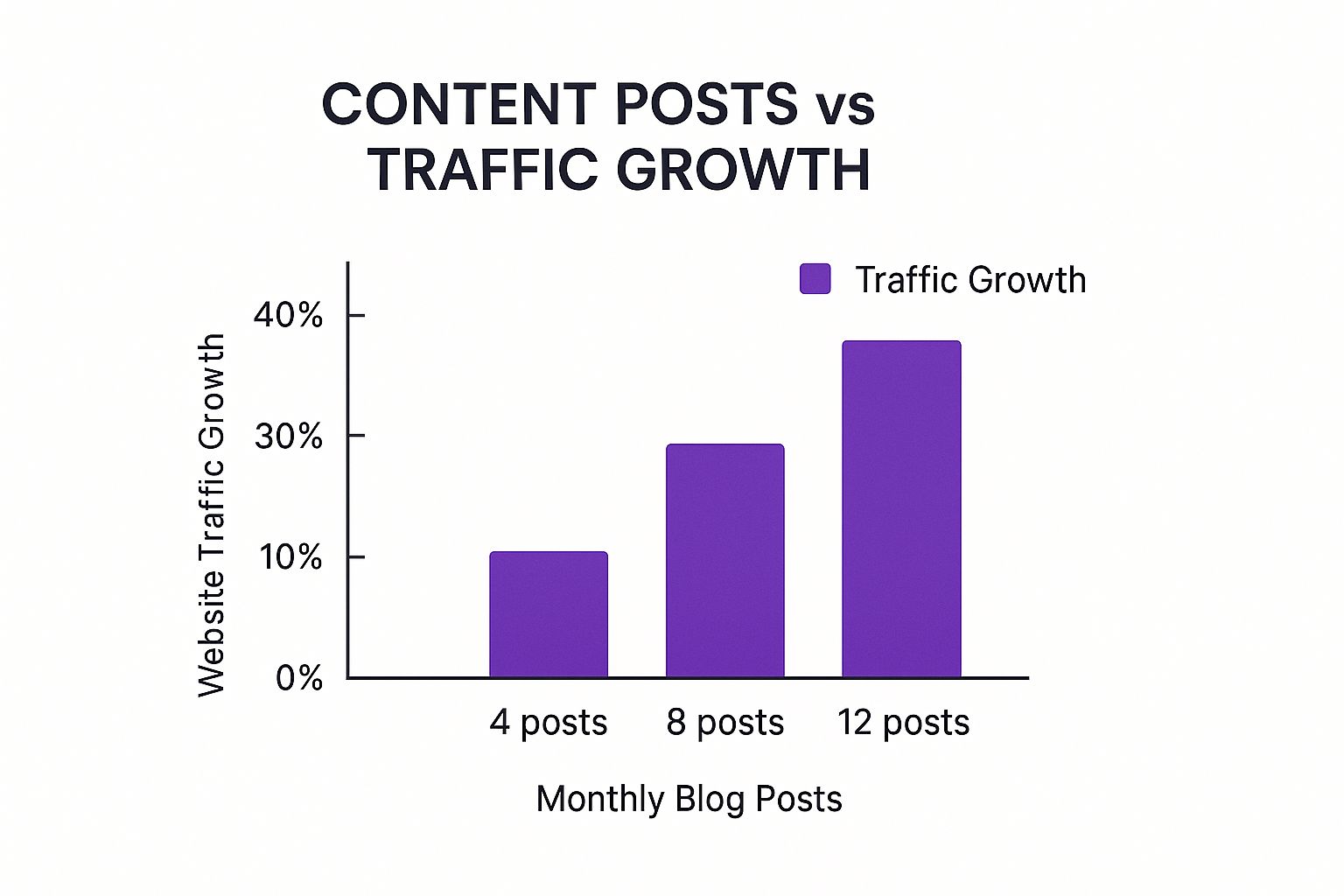
The correlation is clear: the more frequently you publish high-quality content, the more your traffic is likely to grow. This doesn't mean you should ever sacrifice quality for quantity, but it hammers home the importance of having a disciplined, organised workflow.
Of course, it’s not just about the slow-and-steady SEO game. Learning the proven strategies to create viral content and boost engagement can give your traffic a massive, immediate injection. When you combine a steady rhythm of valuable, search-optimised content with the occasional viral hit, you create a truly powerful and sustainable engine for growth.
Building Authority with Outreach and Digital PR
Great on-page SEO and stellar content will get you far, but they're only two-thirds of the puzzle. The final, crucial piece for growing your website traffic is authority.
Put simply, Google wants to know what other authoritative websites think about you. When a trusted site links back to yours, it acts as a powerful vote of confidence. It tells search engines your content is valuable and deserves a higher spot in the rankings.

This whole process, often called off-page SEO, is about building your reputation across the web. It's not about spamming forums or buying dodgy links. It's about genuine relationship-building and digital PR.
Find the Right Outreach Opportunities
First things first, you need to find the right websites to connect with. The goal is to spot publications, blogs, and organisations that are not only relevant to your industry but also respected by your target audience in the UK. A single link from a small, niche-specific blog can often be worth more than one from a massive, irrelevant site.
Here are a few places I always start my search:
- Industry Publications: Look for the established online magazines and news sites that everyone in your sector reads.
- Reputable Blogs: Find the influential bloggers who write for the same people you're trying to reach.
- Community Hubs: Think about non-commercial organisations, local business groups, or even educational institutions that might find your content genuinely useful for their members.
I'd recommend creating a simple spreadsheet to keep track of your prospects. Note down their website, a contact name if you can find one, and a quick sentence on why a link from them would make sense. Staying organised is absolutely key to a successful outreach campaign.
Master the Art of Personalised Outreach
Once you have your target list, it's time to reach out. Let's be honest, generic, templated emails are deleted on sight. Success here comes from personalisation and showing you’ve actually done your homework.
Your email needs to be short, sharp, and clear about the value you're offering. A huge mistake is starting by asking for a link. Instead, focus on building a relationship first. You could offer a unique bit of data from your own research, compliment a recent article they published, or suggest how your content could genuinely help their readers.
Key Takeaway: The golden rule of outreach is to give before you ask. Provide real value upfront without expecting anything in return. This builds goodwill and makes it far more likely your request will be met with a "yes" when you eventually make it.
For a deeper dive into building a strong backlink profile, our guide on https://www.bare-digital.com/how-to-build-backlinks/ is packed with practical strategies you can use right away.
Use Digital PR to Earn Natural Links
Digital PR is where things get really powerful. It’s the art of creating compelling stories and assets that journalists and bloggers want to cover. Instead of you chasing links, the links start coming to you. This is one of the most sustainable ways to build authority and drive a ton of referral traffic.
Effective digital PR campaigns often revolve around a few core ideas:
- Create "Link-Worthy" Assets: This could be anything from an original research report or a handy interactive tool to a detailed infographic or a powerful case study. The trick is to create something unique and genuinely newsworthy.
- Promote Your Story: Once you have your asset, you need to get it in front of the right people. This means targeted outreach to journalists, bloggers, and influencers who cover your specific topic.
- Capitalise on Trends: Keep an eye on the news. If a trending topic relates to your expertise, you can quickly produce a comment or a piece of content and offer it to journalists who are scrambling for expert sources.
A massive part of this is developing a robust thought leadership strategy, which seriously boosts your brand's reputation and reach. When you're seen as the go-to expert, earning links becomes a natural byproduct of your work.
Diversifying Your Traffic Sources Beyond SEO
Relying solely on Google for your traffic is like building your house on rented land. Sure, SEO is a powerful and absolutely essential strategy, but one surprise algorithm update or a change in search behaviour can send your visitor numbers plummeting overnight. To build a resilient, long-term traffic strategy, you have to diversify where your visitors come from.

Think of it as creating a balanced portfolio of traffic streams. By building a presence on social media, nurturing an email list, and making smart use of paid advertising, you create multiple pathways for your audience to find you. This makes your business far more stable and scalable.
Tap into Social Media for Targeted Traffic
Social media isn't just for posting company updates; it’s a powerful engine for driving qualified traffic straight to your website. The secret is to be selective. Instead of trying to be everywhere at once, focus your efforts on the platforms where your UK audience actually spends their time.
- For B2B companies, LinkedIn is usually the best bet for sharing industry insights, case studies, and professional content.
- For visually-driven brands in sectors like fashion, food, or travel, Instagram and Pinterest are perfect for showing off products and inspiring users to click through to your site.
- For businesses targeting a wider consumer base, a well-managed Facebook page can be incredibly effective for building a community and sharing helpful articles.
Your goal is to create content that feels native to the platform—natural and engaging—always with a clear call-to-action encouraging people to visit your site for more detail. Your social profiles are like outposts, all guiding people back to your central hub: your website.
Re-engage Your Audience with Email Marketing
Email marketing is still one of the most reliable ways to drive repeat traffic. Unlike social media, where unpredictable algorithms dictate who sees your content, your email list is a direct line to people who’ve already raised their hands and shown an interest in your brand.
Start by placing simple sign-up forms in strategic spots on your website, like inside blog posts, in the footer, or as a non-intrusive pop-up. You need to offer a compelling reason to subscribe, such as a free guide, a handy checklist, or a discount. Once you have subscribers, it's all about nurturing that relationship with genuinely valuable content.
Key Insight: Don't just bombard people with promotions. Your email newsletter should provide real value. Share your best articles, offer exclusive tips, or give subscribers a behind-the-scenes look at your business. This builds trust and keeps them clicking back to your site month after month.
This approach turns one-time visitors into a loyal community. When you publish a new article or launch a new service, that email list becomes your most engaged and immediate source of traffic. For those running e-commerce sites, there are even more specific proven strategies to drive traffic to a Shopify store that can offer tailored ideas.
Invest in Paid Channels for Scalable Growth
While organic methods are the foundation of any good strategy, paid advertising lets you hit the accelerator and reach a highly specific audience with precision. When you're ready to invest, platforms like Google Ads and social media advertising can deliver a fantastic return.
With paid search (PPC), you can put your website in front of users at the very moment they're searching for a solution you provide. Social media ads, on the other hand, let you target people based on their demographics, interests, and online behaviour.
Even a small, well-managed budget can go a surprisingly long way. For instance, a local service business in Cambridgeshire could run a Facebook ad campaign targeting homeowners in a specific postcode who have shown an interest in home improvement. You just can't get that level of granular targeting with organic methods alone. When done right, paid ads drive not just traffic, but high-quality leads and sales. And for online stores, that traffic must convert, which is why understanding e-commerce conversion rate optimisation is a crucial piece of the puzzle.
Prioritise the Mobile Experience
It doesn't matter which channel you use; a huge chunk of your traffic will come from mobile devices. As of April 2025, mobile phones accounted for nearly 60% of global website traffic, a trend we see reflected strongly here in the UK. That’s a massive jump from less than 35% in 2015, and it proves that a mobile-friendly experience is no longer optional.
This means your website absolutely must be fast, responsive, and easy to use on a small screen. A clunky, slow-loading mobile site will send visitors bouncing away, no matter how they found you in the first place.
Frequently Asked Questions
Got questions about growing your website's traffic? You're not alone. Here are some of the most common queries we get from businesses, along with our straightforward, no-nonsense answers.
How Long Does It Take to See SEO Results in the UK?
This is the million-pound question, isn't it? While everyone wants a fast track, real SEO takes time. You should typically expect to see initial movement within 3 to 6 months.
For highly competitive keywords in the UK market, achieving those coveted top spots and seeing a significant uptick in traffic can take anywhere from 6 to 12 months.
Of course, some early wins, like getting indexed faster or ranking for less competitive long-tail keywords, might pop up sooner. But the key to lasting success is consistency. The timeline really depends on a few things:
- Your website's age and current authority.
- How crowded your industry is online.
- The quality and consistency of your SEO efforts.
Think of it as a long-term investment that gathers momentum over time, not an overnight fix.
Is It Better to Create New Content or Update Old Posts?
Honestly, the best approach is a bit of both. You can't just do one or the other.
Creating brand-new content is vital for targeting fresh keywords, building out your expertise on a topic, and reaching new audiences. It shows you're active and keeps your site from going stale.
However, updating your older content—sometimes called 'historical optimisation'—can deliver much quicker wins. Those old posts might already have some authority and a few backlinks pointing to them.
By refreshing them with new information, tightening up the on-page SEO, and making sure they match what users are searching for today, you can often get a serious traffic boost for less effort than starting from scratch. We always advise clients to build a strategy that dedicates time to both.
What Is the Best Metric for Measuring Traffic Success?
While it’s tempting to just look at 'Total Users' or 'Sessions', those numbers don't tell the whole story. They're just vanity metrics without context.
A much more insightful metric is 'Organic Traffic by Landing Page', viewed alongside engagement signals like 'Average Engagement Time' and, most importantly, 'Conversions'.
This combination tells you which specific pages are actually pulling people in from Google. More than that, it reveals whether those visitors found the content valuable enough to stick around and do something meaningful.
Ultimately, the 'best' metric ties directly back to your business goals.
- For an e-commerce shop, it's probably the 'Conversion Rate from Organic Traffic'.
- For a blog driving leads, it might be 'Newsletter Sign-ups from Blog Posts'.
Focus on the numbers that show a real return on your efforts and align with what you're trying to achieve as a business.
At Bare Digital, we turn these strategies into tangible, measurable results with our bespoke SEO services. We offer a free, no-obligation SEO Health Check that pinpoints exactly where the opportunities lie for your business. Get your tailored activity plan and discover how we can boost your rankings, traffic, and conversions.


